Difference between revisions of "Mamiya Six II"
(Created page with "{{WIP}} {|class=plainlinks align="center" style="text-align: center;" |bgcolor="#A9F5F2" | PLEASE DO NOT LINK THIS PAGE UNTIL FINISHED--MY SANDBOX IS OVERFLOWING |} The Mamiya...") |
Hanskerensky (talk | contribs) m (→Mamiya Six IIa: Redirected Link URL to archived version, Dirk, if you see this, what about the first lines of this article ?) |
||
| (8 intermediate revisions by 4 users not shown) | |||
| Line 10: | Line 10: | ||
Even though numbered Mamiya II, this is in fact the third model to have been introduced. Like the [[Mamiya_Six#Mamiya Six Ia|Mamiya Six Ia]], this model has a red double exposure warning pane in the rangefinder window. The [[Mamiya Six II]] is essentially a [[Mamiya Six III]] design without the flash contacts. In common with the [[Mamiya Six III]] it also has the slightly smaller [[Mamiya_Six_Design_Variations#Name Plate | waist level viewfinder]] (10 x 10 mm) and a smooth rim to the central viewfinder window. | Even though numbered Mamiya II, this is in fact the third model to have been introduced. Like the [[Mamiya_Six#Mamiya Six Ia|Mamiya Six Ia]], this model has a red double exposure warning pane in the rangefinder window. The [[Mamiya Six II]] is essentially a [[Mamiya Six III]] design without the flash contacts. In common with the [[Mamiya Six III]] it also has the slightly smaller [[Mamiya_Six_Design_Variations#Name Plate | waist level viewfinder]] (10 x 10 mm) and a smooth rim to the central viewfinder window. | ||
| − | The production of Mamiya Six II models alongside the [[Mamiya Six III]] | + | The production of Mamiya Six II models alongside the [[Mamiya Six III]] resumed in mid 1946 or early 1947. The price control list of 25 August 1947<ref>The US authorities managing in post-war Japan set up a price control system that regulated not only how much manufacturers could charge for their products but also the resulting wholesale (5.5% mark-up) and retail prices (additional 15.6-15.8% mark up).</ref> includes the Mamiya Six II at a retail price of ¥8540<ref>The ex factory price was ¥7000, with the whole sale price ¥7385. Director General of the Price Board Wada Hiroo. Controlled Prices for home-made [= domestic production, <i>Ed.</i>] camera and its accessory (abolishes Minustry of Finance Notification nº 467 of June 1946). Price Board Notification No. 494 of 25 August 1947. Official Gazette (English Version) nº 421, 25 August 1947, pp. 6-8.[Tokyo: Government Printing Bureau].</ref> Less than a month later the price was set at ¥12220.<ref> The ex factory price was ¥10020, with the whole sale price ¥10571. Director General of the Price Board Wada Hiroo. Controlled Prices for home-made [= domestic production, <i>Ed.</i>] camera and its accessory (abolishes Price Board Notification nº 494 of August 1947). Price Board Notification No. 554 of 3 September 1947. Official Gazette (English Version) nº 429, 3 September 1946, pp. 2-4.[Tokyo: Government Printing Bureau].</ref> |
== Technical details == | == Technical details == | ||
| − | :Like the [[Mamiya Six III]] from which this model is derived, the Mamiya Six II has the smaller waist level finder (10 x10 mm) and the dimpled shutter release button. The [[Mamiya_Six_Design_Variations#Pressure Plate Support | guide rail for the removable pressure plate]] runs for the length of the film gate and now exhibits an embossed directional arrow. | + | :Like the [[Mamiya Six III]] from which this model is derived, the Mamiya Six II has the [[Mamiya_Six_Design_Variations#Name Plate | smaller waist level finder]] (10 x10 mm) and the [[Mamiya_Six_Design_Variations#Shutter Release | dimpled shutter release button]]. The [[Mamiya_Six_Design_Variations#Pressure Plate Support | guide rail for the removable pressure plate]] runs for the length of the film gate and now exhibits an embossed directional arrow. |
| − | + | : <br>''Distinguishing Pre-War and Post-War Production'' | |
| − | + | :Pre-war and wartime units can be readily recognised by the [[Mamiya_Six_Design_Variations#Film Advance Knob | solid, cylindrical knob]] of the film advance, and by the use of [[Mamiya_Six_Design_Variations#Flash Shoe | three screws]] to fasten the flash-shoe. Post-war units have a [[Mamiya_Six_Design_Variations#Film Advance Knob | mushroom-shaped knob]] of the film advance, and use [[Mamiya_Six_Design_Variations#Flash Shoe | two screws]] (set diagonally) to fasten the flash-shoe. | |
===Dimensions=== | ===Dimensions=== | ||
:145 x 107 x 53mm (105mm open); 783g <ref> With a K.O.L. Special 75mm f3.5 in NKS–TOKIO '0' shutter with T, B, 1-1/200 sec</ref> | :145 x 107 x 53mm (105mm open); 783g <ref> With a K.O.L. Special 75mm f3.5 in NKS–TOKIO '0' shutter with T, B, 1-1/200 sec</ref> | ||
| Line 30: | Line 30: | ||
<center> | <center> | ||
{|class=plainlinks align="center" style="text-align: center;" | {|class=plainlinks align="center" style="text-align: center;" | ||
| − | ||[http://www.flickr.com/photos/heritagefutures/5143934611/in/pool- | + | ||[http://www.flickr.com/photos/heritagefutures/5143934611/in/pool-camerawiki http://farm2.static.flickr.com/1192/5143934611_684fbccfb5_m.jpg] |
| − | ||[http://www.flickr.com/photos/heritagefutures/5143939851/in/pool- | + | ||[http://www.flickr.com/photos/heritagefutures/5143939851/in/pool-camerawiki http://farm5.static.flickr.com/4144/5143939851_bc3e0a561e_m.jpg] |
| − | ||[http://www.flickr.com/photos/heritagefutures/5144551752/in/pool- | + | ||[http://www.flickr.com/photos/heritagefutures/5144551752/in/pool-camerawiki http://farm2.static.flickr.com/1317/5144551752_43b594af00_m.jpg] |
|- | |- | ||
| − | ||[http://www.flickr.com/photos/heritagefutures/4995254201/in/pool- | + | ||[http://www.flickr.com/photos/heritagefutures/4995254201/in/pool-camerawiki http://farm5.static.flickr.com/4146/4995254201_5a2e26d2d7_m.jpg] |
| − | ||[http://www.flickr.com/photos/heritagefutures/4995860410/in/pool- | + | ||[http://www.flickr.com/photos/heritagefutures/4995860410/in/pool-camerawiki http://farm5.static.flickr.com/4085/4995860410_7749e2965d_m.jpg] |
| − | ||[http://www.flickr.com/photos/heritagefutures/5144543298/in/pool- | + | ||[http://www.flickr.com/photos/heritagefutures/5144543298/in/pool-camerawiki http://farm5.static.flickr.com/4008/5144543298_f85e22c475_m.jpg] |
|- | |- | ||
| − | | colspan=3 | | + | | colspan=3 | Mamiya Six Model II sn#9518 with a [[Kajiro_Kōgaku|K.O.L.]] Special 75mm f/3.5 in [[NKS]]–TOKIO '0' shutter with T, B, 1-1/200 sec<br/><small>Images by {{image author| Dirk HR Spennemann}}</small> {{with permission}} |
|} | |} | ||
</center> | </center> | ||
=Mamiya Six IIa= | =Mamiya Six IIa= | ||
| − | As with the Mamiya Ia, this version of the Mamiya II allowed to use the larger (type '0', 58mm) shutters, which required to use a simplified two-strut mechanism for the front door. This version was designed for photographers who wished to have faster (and thus usually larger diameter) shutters or have their own shutter and lens combinations installed.<ref>Mamiya History Pages, [http://www.mamiya.co.jp/home/camera/museum/saishu-page/1940/mamiya6-2a.htm | Mamiya Six IIa]</ref> | + | As with the [[Mamiya Six I#Mamiya Six Ia| Mamiya Six Ia]], this version of the Mamiya II allowed to use the larger (type '0', 58mm) shutters, which required to use a simplified [[Mamiya_Six_Design_Variations#Strut Mechanism| two-part strut mechanism]] for the front door. This version was designed for photographers who wished to have faster (and thus usually larger diameter) shutters or have their own shutter and lens combinations installed.<ref>Mamiya History Pages, [https://web.archive.org/web/20130826072012/http://www.mamiya.co.jp/home/camera/museum/saishu-page/1940/mamiya6-2a.htm | Mamiya Six IIa] (archived)</ref> |
| + | |||
| + | == Technical details == | ||
| + | :''Distinguishing Pre-War and Post-War Production'' | ||
| + | :Pre-war and wartime units can be readily recognised by the [[Mamiya_Six_Design_Variations#Film Advance Knob | solid, cylindrical knob]] of the film advance, and by the use of [[Mamiya_Six_Design_Variations#Flash Shoe | three screws]] to fasten the flash-shoe. Post-war units have a [[Mamiya_Six_Design_Variations#Film Advance Knob | mushroom-shaped knob]] of the film advance, and use [[Mamiya_Six_Design_Variations#Flash Shoe | two screws]] (set diagonally) to fasten the flash-shoe. | ||
===Dimensions=== | ===Dimensions=== | ||
| Line 60: | Line 64: | ||
<center> | <center> | ||
{|class=plainlinks align="center" style="text-align: center;" | {|class=plainlinks align="center" style="text-align: center;" | ||
| − | ||[http://www.flickr.com/photos/heritagefutures/5256561097/in/pool- | + | ||[http://www.flickr.com/photos/heritagefutures/5256561097/in/pool-camerawiki http://farm6.static.flickr.com/5006/5256561097_791e915a88_m.jpg] |
| − | ||[http://www.flickr.com/photos/heritagefutures/5257172236/in/pool- | + | ||[http://www.flickr.com/photos/heritagefutures/5257172236/in/pool-camerawiki http://farm6.static.flickr.com/5127/5257172236_2a705b280e_m.jpg] |
| − | ||[http://www.flickr.com/photos/heritagefutures/5256566663/in/pool- | + | ||[http://www.flickr.com/photos/heritagefutures/5256566663/in/pool-camerawiki http://farm6.static.flickr.com/5043/5256566663_5798ea18b5_m.jpg] |
|- | |- | ||
| − | ||[http://www.flickr.com/photos/heritagefutures/5257169820/in/pool- | + | ||[http://www.flickr.com/photos/heritagefutures/5257169820/in/pool-camerawiki http://farm6.static.flickr.com/5170/5257169820_66879b343d_m.jpg] |
| − | ||[http://www.flickr.com/photos/heritagefutures/5256558787/in/pool- | + | ||[http://www.flickr.com/photos/heritagefutures/5256558787/in/pool-camerawiki http://farm6.static.flickr.com/5246/5256558787_8c2c468d53_m.jpg] |
| − | ||[http://www.flickr.com/photos/heritagefutures/5256563413/in/pool- | + | ||[http://www.flickr.com/photos/heritagefutures/5256563413/in/pool-camerawiki http://farm6.static.flickr.com/5247/5256563413_3c2aa18b11_m.jpg] |
|- | |- | ||
| − | | colspan=3 | | + | | colspan=3 | Mamiya Six Model IIa sn# 22344 with T.S.M. Anastigmat f/3.5 75mm in [[Olympus|OLYMPUS]]-TOKYO-N KOHO shutter (B, T, 1-200th) <br/><small>Images by {{image author| Dirk HR Spennemann}}</small> {{with permission}} |
|} | |} | ||
</center> | </center> | ||
| Line 76: | Line 80: | ||
{|class=plainlinks align="center" style="text-align: center;" | {|class=plainlinks align="center" style="text-align: center;" | ||
| − | ||[http://www.flickr.com/photos/heritagefutures/5254049972/in/pool- | + | ||[http://www.flickr.com/photos/heritagefutures/5254049972/in/pool-camerawiki http://farm6.static.flickr.com/5210/5254049972_03549fbf5c_m.jpg] |
|- | |- | ||
| − | | | War- | + | | | War-time advertising brochure<ref>The brochure covers the [[Mamiya Six III]], but has one page for the [[Mamiya Six I|Mamiya Six I/IA]] and for the Mamiya Six II/IIA</ref><br/><small>Images by {{image author| Dirk HR Spennemann}}</small> {{with permission}} |
|} | |} | ||
= Notes = | = Notes = | ||
<references /> | <references /> | ||
| + | |||
| + | |||
| + | [[Category: Japanese 6x6 rangefinder folding]] | ||
| + | [[Category: Mamiya]] | ||
| + | [[Category: M]] | ||
| + | [[Category: S|Six, Mamiya]] | ||
| + | [[Category:Advertising (historic)]] | ||
Latest revision as of 06:10, 23 February 2018
| PLEASE DO NOT LINK THIS PAGE UNTIL FINISHED--MY SANDBOX IS OVERFLOWING |
The Mamiya Six II was introduced sometime in 1941 and initially sold for ¥384.[1]
[2]
Even though numbered Mamiya II, this is in fact the third model to have been introduced. Like the Mamiya Six Ia, this model has a red double exposure warning pane in the rangefinder window. The Mamiya Six II is essentially a Mamiya Six III design without the flash contacts. In common with the Mamiya Six III it also has the slightly smaller waist level viewfinder (10 x 10 mm) and a smooth rim to the central viewfinder window.
The production of Mamiya Six II models alongside the Mamiya Six III resumed in mid 1946 or early 1947. The price control list of 25 August 1947[3] includes the Mamiya Six II at a retail price of ¥8540[4] Less than a month later the price was set at ¥12220.[5]
Contents
Technical details
- Like the Mamiya Six III from which this model is derived, the Mamiya Six II has the smaller waist level finder (10 x10 mm) and the dimpled shutter release button. The guide rail for the removable pressure plate runs for the length of the film gate and now exhibits an embossed directional arrow.
-
Distinguishing Pre-War and Post-War Production - Pre-war and wartime units can be readily recognised by the solid, cylindrical knob of the film advance, and by the use of three screws to fasten the flash-shoe. Post-war units have a mushroom-shaped knob of the film advance, and use two screws (set diagonally) to fasten the flash-shoe.
Dimensions
- 145 x 107 x 53mm (105mm open); 783g [6]
Lens and shutter combinations

|
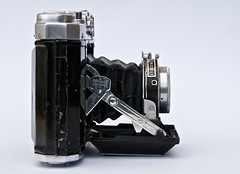
|
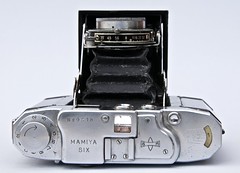
|
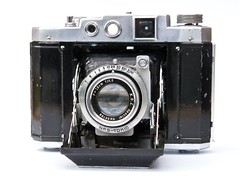
|
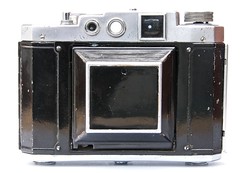
|
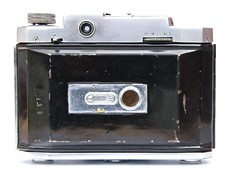
|
| Mamiya Six Model II sn#9518 with a K.O.L. Special 75mm f/3.5 in NKS–TOKIO '0' shutter with T, B, 1-1/200 sec Images by Dirk HR Spennemann (Image rights) | ||
Mamiya Six IIa
As with the Mamiya Six Ia, this version of the Mamiya II allowed to use the larger (type '0', 58mm) shutters, which required to use a simplified two-part strut mechanism for the front door. This version was designed for photographers who wished to have faster (and thus usually larger diameter) shutters or have their own shutter and lens combinations installed.[9]
Technical details
- Distinguishing Pre-War and Post-War Production
- Pre-war and wartime units can be readily recognised by the solid, cylindrical knob of the film advance, and by the use of three screws to fasten the flash-shoe. Post-war units have a mushroom-shaped knob of the film advance, and use two screws (set diagonally) to fasten the flash-shoe.
Dimensions
- 145 x 108 x 53 mm closed (105mm open); weight:827g[10]
Lens and shutter combinations
- K.O.L. Special f/3.5 75mm
- in WESTER-MODEL-I shutter (T, B, 1-200th)[11]
- T.S.M. Anastigmat f/3.5 75mm
- Carl Zeiss Jena Tessar f/2.8 7.5cm

|

|

|
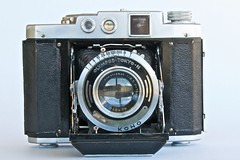
|
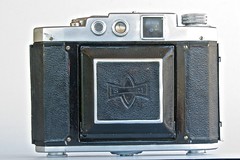
|

|
| Mamiya Six Model IIa sn# 22344 with T.S.M. Anastigmat f/3.5 75mm in OLYMPUS-TOKYO-N KOHO shutter (B, T, 1-200th) Images by Dirk HR Spennemann (Image rights) | ||
Brochures and Manuals
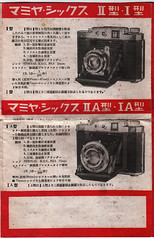
|
| War-time advertising brochure[14] Images by Dirk HR Spennemann (Image rights) |
Notes
- ↑ Mamiya. A History of Innovation. Mamiya 50th Anniversary. Produced by the Mamiya-History of Innovation Editorial Committee. Bunkyo-ku, Tokyo: Mamiya Camera Co. Ltd. p.4
- ↑ Asahi Camera ¶¶¶¶¶ | Neco's Mamiya site
- ↑ The US authorities managing in post-war Japan set up a price control system that regulated not only how much manufacturers could charge for their products but also the resulting wholesale (5.5% mark-up) and retail prices (additional 15.6-15.8% mark up).
- ↑ The ex factory price was ¥7000, with the whole sale price ¥7385. Director General of the Price Board Wada Hiroo. Controlled Prices for home-made [= domestic production, Ed.] camera and its accessory (abolishes Minustry of Finance Notification nº 467 of June 1946). Price Board Notification No. 494 of 25 August 1947. Official Gazette (English Version) nº 421, 25 August 1947, pp. 6-8.[Tokyo: Government Printing Bureau].
- ↑ The ex factory price was ¥10020, with the whole sale price ¥10571. Director General of the Price Board Wada Hiroo. Controlled Prices for home-made [= domestic production, Ed.] camera and its accessory (abolishes Price Board Notification nº 494 of August 1947). Price Board Notification No. 554 of 3 September 1947. Official Gazette (English Version) nº 429, 3 September 1946, pp. 2-4.[Tokyo: Government Printing Bureau].
- ↑ With a K.O.L. Special 75mm f3.5 in NKS–TOKIO '0' shutter with T, B, 1-1/200 sec
- ↑ sn# 9518.—Photographica Collection Dirk HR Spennemann | (Flickr image).—Also illustrated on the back panel of a Brochure (1943?) on the Mamiya Six III
- ↑ sn#19513—Photographica Collection Dirk HR Spennemann
- ↑ Mamiya History Pages, | Mamiya Six IIa (archived)
- ↑ With a T.S.M. Anastigmat f/3.5 75mm in OLYMPUS-TOKYO-N KOHO shutter (B, T, 1-200th)
- ↑ Illustrated on the back panel of a Brochure (1943?) on the Mamiya Six III
- ↑ sn#22344—Photographica Collection Dirk HR Spennemann
- ↑ | Neco's Mamiya Site
- ↑ The brochure covers the Mamiya Six III, but has one page for the Mamiya Six I/IA and for the Mamiya Six II/IIA